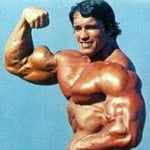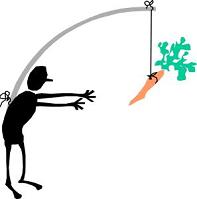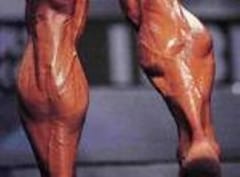Archive for the ‘Fitness Tips’ Category
Monday, March 22nd, 2010
As most of you know, I am not a huge advocate of biceps training. I think the biceps get worked pretty hard in you train your back correctly using pull ups, chin ups, and various rows. See my post on the top 5 best back exercises.
In reality you probably only like 4-6 total sets of biceps training a week. That would be 2 sets for 2 or 3 exercises a week, spread out over the course of the week. Choose your biceps exercises based on my list of the top 5 best biceps exercises.
At least if you are going to train your bis, whether twice a week or with a dedicated arms day consisting of 8 biceps exercises, let me tell you how to get the most out of each rep.
(more…)
Tags: arms, biceps, bis, curling, curls, Weight Training, weightlifting
Posted in Fitness Tips | 11 Comments »
Friday, March 19th, 2010
Blow It Out, Suck It In
When doing crunches, sit ups, or any other abdominal work, you should always blow out forcefully at the top of the movement and suck your abs in for a full contraction.
In order to flex your abs and contract them fully, you need to blow all of the air out of your lungs and abdomen. When you do this your abs will experience maximal contraction and will actually work harder to perform the exercise.
Isometric Contractions
For a slimming isometric exercise simply stand up straight, tighten your abdominals, blow all of the air out of your lungs and abdomen, and hold the contraction for 30 seconds.
Do this for 5 minutes a day every day, and you will actually see results after a couple weeks.
Do this all day every day, and you will actually train your abs to stay tight and flat permanently.
Tags: abdominals, abs, six pack
Posted in Fitness Tips | 4 Comments »
Wednesday, March 17th, 2010
Your core is extremely important – so important that the word “core” has become somewhat of a catch phrase in today’s fitness society. Core training is used nowadays as the focus of group exercise classes, 30 minute workout routines, and garners an entire niche in resistance training.
As a unit, the “core” refers to all of the muscles from your hips to your rib cage, front to back. The transverse abdominals, multifidus, internal and external obliques, rectus abdominus, and erector spinae (lower back). The latissimus dorsi, glutes, and trapezius are secondary core muscles.
(more…)
Posted in Fitness Tips, Videos | No Comments »
Monday, March 15th, 2010
The best way I have found to stay motivated to train, is to keep track of my stats.
Here are some statistics you can use to measure your progress at the gym:
- Pictures of your body.
- Videos of you posing or training.
- Measurements using a tape measure:
- Neck
- Shoulders
- Chest/Back
- Arms
- Waist at belt level
- Waist at belly button
- Hips
- Quads
- Hamstrings
- Calves
(more…)
Tags: Diet, dieting, Fitness Tips, Motivation, Weight Training, weightlifting, Workout Logs
Posted in Fitness Tips, Motivation | No Comments »
Friday, March 12th, 2010
Increasing Your Vertical Jumping Ability
A single vertical jump for maximum height is one of the most intense exercises you can do.
Why? Because it requires you to utilize your entire lower body chain in a maximal effort contraction, to produce a maximal amount of force in a split second.
The important aspects of training to work on, to increase your vertical leap include:
- Squatting strength – Maximal leg strength transfers directly to a vertical jump. A strong 1 rep max = a big jump.
- Squatting speed – The faster you can squat, the more power you can generate, the higher you can jump.
- Squatting power – Tied in directly with speed and strength, squat heavier and squat faster and you will jump higher.
- Acceleration – You want to continue accelerating out of the hole all the way through the top of your jump.
- Single leg strength – To eliminate strength imbalances and to improve neuromuscular coordination, train your legs individually.
- Calf strength – Your calves are used at the end of the jump, so max calf strength can mean an extra inch on your vert.
- Sprint speed – Sprinting trains the Type-II Fast Twitch muscle fibers, which are what you need to attain your highest jump. Acceleration applies here as well.
- Hip drive – Your hips are responsible for a significant portion of jumping power from a parallel squat position to standing.
- Glute activation – Your glutes are responsible for driving you out of the hole at the bottom of a squat or jump.
(more…)
Tags: glutes, hips, jump squat, jumping, jumping rope, jumps, leaping, leg training, legs, plyometrics, squats, squatting, vertical
Posted in Conditioning, Fitness Tips, Weight Training, Workout Routines | 4 Comments »
Wednesday, March 10th, 2010
Double Your Calf Size with These Two Simple Tips
Calves tend to be a bodybuilding problem spot. Even Arnold used to worry about the size of his calves in relation to the rest of his body.
Here is a simple tip to double the size of your calves in no time:
Since your calves are made up of two muscle groups, you will need to train your calves in a standing and seated position. Most calf exercises can be tweaked to include straight-knee and bent-knee variations. Use them both.
(more…)
Tags: bodybuilding, calf training, calves, legs, weight lifting, Weight Training, weightlifting
Posted in Fitness Tips | 2 Comments »
Monday, March 8th, 2010
How to Train with a Busted Arm or Leg
When you hurt one of your arms, you shouldn’t necessarily stop exercising the healthy arm.
A study at the University of Oklahoma suggests that when you train a single arm (or leg), the muscle nerve fibers in the opposite appendage are stimulated. This means you will still get the benefits of Central Nervous System (CNS) adaptations in an injured limb as long as you train the opposite healthy limb, over a short period of time.
(more…)
Tags: arms, injuries, injury, legs, Medical, Weight Training
Posted in Fitness Tips | 3 Comments »
Thursday, March 4th, 2010
Is there an exercise that you hate? For some people it’s squats, for some it’s deadlifts, and for others it could be something that most of us consider fun, like dips or the ab wheel.
An Entire Exercise Could Be Your Weak Spot
If you any any particular exercise because it is hard, awkward, or uncomfortable, then you have probably found your weak spot.
Depending on the exercise, the main muscle used and/or the ancillary muscles used, are probably weak points for you. There is likely a muscle imbalance, or at least a weak muscle that should be prioritized for a couple months.
The best exercise you can do to bring up your weak point, is the exercise that you hate.
(more…)
Tags: Medical, plateaus, Weight Training, weightlifting, workout
Posted in Fitness Tips | 5 Comments »
Wednesday, March 3rd, 2010
Trying to build a rippling, powerful, V-shaped back?
Trying to max out rear-view sexiness for bikini season?
If you said “Yes!” then you should use these tips for isolating your back muscles when training with pull-ups, pull-downs, and rows.
(more…)
Tags: back, fitness, Fitness Tips, weight lifting, Weight Training, weightlifting, weights
Posted in Fitness Tips | No Comments »
Friday, February 26th, 2010
So you want to be a dolphin. Or perhaps you want to be a competitive swimmer. Or maybe you just want to swim faster.
Unless you are really lucky (or would that be unlucky?) you probably weren’t born with webbed feet or toes, so you will have to look at other ways to increase your speed in the water.
The best way to increase your swimming speed, is to increase the flexibility of your ankles. Flexible ankles act like flippers, which will help to propel you through the water faster.
(more…)
Tags: Flexibility, flexibility training, swimming
Posted in Fitness Tips | No Comments »
Thursday, February 25th, 2010
There is a ton of weightlifting equipment out there and the bench is one of the most important pieces.
As with all purchases, you should do your due diligence. Of course if you are ordering a weight bench or browsing the stores, you will want to do your initial research into product quality, customer reviews, and the amount of time the weight bench manufacturer has been in business.
After that, you should examine and try out each bench before you make your decision. Listed below are some common criteria for selecting a bench that will make you happy and keep you safe.
(more…)
Tags: bench press, benching, chest training, Exercise Equipment, workout
Posted in Fitness Tips | No Comments »
Wednesday, February 24th, 2010
Back in the day you might have been told to avoid situps because they can strain your lower back and neck. That could be true if you have bad form, but it is generally a myth to avoid doing situps in favor of crunches.
It is a myth perpetuated in the 1990s and early 2000s by foo foo personal trainers trying to convince middle-aged overweight Americans that they don’t have to do situps to get good abs, and in fact doing situps is ‘bad’.
Bollocks I say! We can file that one up there with high carb / low fat diets and curling in the squat rack.
To protect your neck, read the post on How to Reduce Neck Strain.
To protect your back, the answer is simple: keep your back as straight as possible throughout the movement, lay on a towel or mat to protect your tailbone, and avoid anchoring your feet as that can sometimes cause lower back strain.
(more…)
Tags: abdominals, abs, crunches, situps, training, Training Articles
Posted in Fitness Tips | 14 Comments »
Tuesday, February 23rd, 2010
You want to save time building muscle and losing fat. You want to put in as little time as possible, using as few days out of the week as possible, and get the most bang for your buck. In that case you should exercise only when you can maximize your returns on time invested. Here’s how:
(more…)
Tags: build muscle, exercise, fat loss, fitness, gain muscle, lose fat, lose weight, weight loss
Posted in Fitness Tips | 2 Comments »
Monday, February 22nd, 2010
There are so many choices out there for exercise equipment, sometimes it is hard to know what to choose. Free weights are always best – barbells, dumbbells, kettlebells, odd objects, and even bodyweight. Machines have their place, but they don’t usually belong in your main training routine.
So how can you choose your equipment based on your training history, goals, and injuries?
(more…)
Tags: barbell, dumbbell, exercise, Exercise Equipment, fitness, Weight Training, weightlifting
Posted in Fitness Tips | 1 Comment »
Sunday, February 21st, 2010
Keep your muscles limber by holding static stretches for 30 seconds if you are under 30 years old. For every ten additional years of your life, you should add 10 seconds to your stretch.
Example: in your 30’s you should be holding a stretch for 40 seconds, in your 40’s hold it for 50 seconds, in your 50’s it should be a 60 second hold, and so on.
The reason is for this is that your muscles are less pliable as you get older. You need to stretch them for longer periods of time to remain flexible in your old age.
Static stretching should always be completed after your regular exercise routine. Dynamic and PNF stretching can be done during warm-ups or after regular training. If you are interested, you should read more about Flexibility Training.
Tags: dynamic stretching, Flexibility, flexibility training, pnf stretching, static stretching, stretching
Posted in Fitness Tips | No Comments »
Friday, February 19th, 2010
Don’t work your abdominal muscles every day. Your abs are like any other muscle in your body – you shouldn’t work them everyday. You still need to give your abs time to recover.
You should train your abs 3 to 4 times a week, not on consecutive days.
(more…)
Tags: abdominals, abs, Fitness Tips, tips
Posted in Fitness Tips | 1 Comment »





















